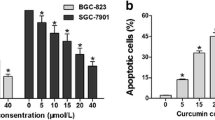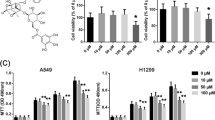Abstract
Sanguinarine (SAN), a quaternary benzophenanthridine alkaloid extracted from the root of Papaveraceae plants, has shown antitumour effects in multiple cancer cells. However, the therapeutic effects and the underlying mechanisms of SAN in gastric cancer (GC) remain elusive. In this study, the in vitro proliferation inhibition effect of SAN in GC cells was determined using CCK-8 assay, the in vivo antitumor effect of SAN was evaluated in mice with xenotransplanted tumor. The mechanism underlying the antitumor activity of SAN was explored by gene microarray assay and bioinformatics analysis. The levels of differentially expressed miRNAs and target genes were verified by real-time RT-PCR and immunohistochemistry. SAN inhibited the proliferation of BGC-823 cells in a concentration-dependent manner in vitro and in vivo. The miR-96-5p and miR-29c-3p were significantly upregulated in untreated BGC-823 cells and significantly downregulated in SAN treated cells. The mRNA and protein expression of their target gene MAP4K4 were upregulated in SAN treated xenotransplanted tumors, and pMEK4 and pJNK1 proteins in the MAPK/JNK signaling pathway were also upregulated by SAN. These indicate that SAN may inhibit the proliferation of BGC-823 cells through the inhibition of miR-96-5p and miR-29c-3p expression, and subsequent activation of the MAPK/JNK signaling pathway.







Similar content being viewed by others
References
Ferro A, Peleteiro B, Malvezzi M, Bosetti C, Bertuccio P, Levi F, Negri E, La Vecchia C, Lunet N (2014) Worldwide trends in gastric cancer mortality (1980–2011), with predictions to 2015, and incidence by subtype. Eur J Cancer 50:1330–1344
Sasako M, Inoue M, Lin JT, Khor C, Yang HK, Ohtsu A (2010) Gastric cancer working group report. Jpn J Clin Oncol 40:i28–i37
Liu GH, Liu YH, Yang Z, Zhu AL, Zhao CL (2016) MicroRNA-524-5p suppresses the growth and invasive abilities of gastric cancer cells. Oncol Lett 11:1926–1932
Ferlay J, Shin HR, Bray F, Forman D, Mathers C, Parkin DM (2010) Estimates of worldwide burden of cancer in 2008: GLOBOCAN 2008. Int J Cancer 127:2893–2917
Zhang R, Wang G, Zhang PF, Zhang J, Huang YX, Lu YM, Da W, Sun Q, Zhu JS (2017) Sanguinarine inhibits growth and invasion of gastric cancer cells via regulation of the DUSP4/ERK pathway. J Cell Mol Med 21:1117–1127
Ajani JA, Bentrem DJ, Besh S, D’Amico TA, Das P, Denlinger C, Fakih MG, Fuchs CS, Gerdes H, Glasgow RE, Hayman JA, Hofstetter WL, Ilson DH, Keswani RN, Kleinberg LR, Korn WM, Lockhart AC, Meredith K, Mulcahy MF, Orringer MB, Posey JA, Sasson AR, Scott WJ, Strong VE, Varghese TK Jr, Warren G, Washington MK, Willett C, Wright CD, McMillian NR, Sundar H (2013) Gastric cancer, version 2.2013: featured updates to the NCCN guidelines. J Natl Compr Cancer Netw 11:531–546
Beuria TK, Santra MK, Panda D (2005) Sanguinarine blocks cytokines is in bacteria by inhibiting FtsZ assembly and bundling. Biochemistry 44:16584–16593
Adhami VM, Aziz MH, Mukhtar H, Ahmad N (2003) Activation of prodeath Bcl-2 family proteins and mitochondrial apoptosis pathway by sanguinarine in immortalized human HaCaT keratinocytes. Clin Cancer Res 9:3176–3182
Gu S, Yang XC, Xiang XY, Wu Y, Zhang Y, Yan XY, Xue YN, Sun LK, Shao GG (2015) Sanguinarine-induced apoptosis in lung adenocarcinoma cells is dependent on reactive oxygen species production and endoplasmic reticulum stress. Oncol Rep 34:913–919
Han MH, Park C, Jin CY, Kim GY, Chang YC, Moon SK, Kim WJ, Choi YH (2013) Apoptosis induction of human bladder cancer cells by sanguinarine through reactive oxygen species-mediated up-regulation of early growth response gene-1. PLoS One 8:e63425
Sun M, C Liu, Nadiminty N, Lou W, Zhu Y, Yang J, Evans CP, Zhou Q, Gao AC (2012) Inhibition of Stat3 activation by sanguinarine suppresses prostate cancer cell growth and invasion. Prostate 72:82–89
De Stefano I, Raspaglio G, Zannoni GF, Travaglia D, Prisco MG, Mosca M, Ferlini C, Scambia G, Gallo D (2009) Antiproliferative and antiangiogenic effects of the benzophenanthridine alkaloid sanguinarine in melanoma. Biochem Pharmacol 78:1374–1381
Singh CK, Kaur S, George J, Nihal M, Pellitteri Hahn MC, Scarlett CO, Ahmad N (2015) Molecular signatures of sanguinarine in human pancreatic cancer cells: a large scale label-free comparative proteomics approach. Oncotarget 6:10335–10348
Ahmad N, Gupta S, Husain MM, Heiskanen KM, Mukhtar H (2000) Differential antiproliferative and apoptotic response of sanguinarine for cancer cells versus normal cells. Clin Cancer Res 6:1524–1528
Kaminskyy V, Lin KW, Filyak Y, Stoika R (2008) Differential effect of sanguinarine, chelerythrine and chelidonine on DNA damage and cell viability in primary mouse spleen cells and mouseleukemic cells. Cell Biol Int 32:271–277
Zhang R, Wang G, Zhang PF, Zhang J, Huang YX, Lu YM, Da W, Sun Q, Zhu JS (2017) Sanguinarine inhibits growth and invasion of gastric cancer cells via regulation of the DUSP4/ERK pathway. J Cell Mol Med 21:1117–1127
Dong XZ, Zhang M, Wang K, Liu P, Guo DH, Zheng XL, Ge XY (2013) Sanguinarine inhibits vascular endothelial growth factor release by generation of reactive oxygen species in MCF-7 human mammary adenocarcinoma cells. Biomed Res Int 2013:517698
Xiao XY, Hao M, Yang XY, Ba Q, Li M, Ni SJ, Wang LS, Du X (2011) Licochalcone A inhibits growth of gastric cancer cells by arresting cell cycle progression and inducing apoptosis. Cancer Lett 302:69–75
Liang T, Zhang XJ, Xue WH, Zhao S, Zhang X, Pei J (2014) Curcumin induced human gastric cancer BGC-823 cells apoptosis by ROS-mediated ASK1-MKK4-JNK stress signaling pathway. Int J Mol Sci 15:15754–15765
Liu HM, Wu Q, Cao JQ, Wang X, Song Y, Mei WJ, Wang XC (2018) A phenanthroline derivative enhances radiosensitivity of hepatocellular carcinoma cells by inducing mitochondria-dependent apoptosis. Eur J Pharmacol 843:285–291
Lin X, Wei JB, Chen YX, He P, Lin J, Tan S, Nie J, Lu S, He M, Lu Z, Huang Q (2016) Isoorientin from Gypsophila elegans induces apoptosis in liver cancer cells via mitochondrial-mediated pathway. J Ethnopharmacol 187:187–194
Wu Y, Wang Y, Zhang Y, Chen LP, Wang JY (2014) Effect of matrine on NO and ADMA metabolism pathways in serum and tissues of mice with lipopolysaccharide-induced intestine tissue inflammation. China J Chin Mater Med 39:2318–2321
Jin H, Qiao F, Wang Y, Xu Y, Shang Y (2015) Curcumin inhibits cell proliferation and induces apoptosis of human non-small cell lung cancer cells through the upregulation of miR-192-5p and suppression of PI3K/Akt signaling pathway. Oncol Rep 34:2782–2789
Yu N, Xiong Y, Wang C (2017) Bu-Zhong-Yi-Qi decoction, the water extract of chinese traditional herbal medicine, enhances cisplatin cytotoxicity in A549/DDP cells through induction of apoptosis and autophagy. Biomed Res Int 2017:3692797
Zhang R, Wang G, Zhang PF, Zhang J, Huang YX, Lu YM, Da W, Sun Q, Zhu JS (2017) Sanguinarine inhibits growth and invasion of gastric cancer cells via regulation of the DUSP4/ERK pathway. J Cell Mol Med 21:1117–1127
Xu JY, Meng QH, Yu C, Jiao Y, Zhao L, Rosen EM, Fan S (2013) Sanguinarine is a novel VEGF inhibitor involved in the suppression of angiogenesis and cell migration. Mol Clin Oncol 1:331–336
Han MH, Kim GY, Yoo YH, Choi YH (2013) Sanguinarine induces apoptosis in human colorectal cancer HCT-116 cells through ROS-mediated Egr-1 activation and mitochondrial dysfunction. Toxicol Lett 220:157–166
De Stefano I, Raspaglio G, Zannoni GF, Travaglia D, Prisco MG, Mosca M, Ferlini C, Scambia G, Gallo D (2009) Antiproliferative and antiangiogenic effects of the benzophenanthridine alkaloid sanguinarine in melanoma. Biochem Pharmacol 78:1374–1381
Vecera R, Klejdus B, Kosina P, Orolin J, Stiborová M, Smrcek S, Vicar J, Dvorák Z, Ulrichová J, Kubán V, Anzenbacher P, Simánek V (2007) Disposition of sanguinarine in the rat. Xenobiotica 37(5):549–558
Satpathi S, Gavvala K, Hazra P (2015) Fluorescence switching of sanguinarine in micellar environments. Phys Chem Chem Phys 17(32):20725–20732
Kang HM, Park BS, Kang HK, Park HR, Yu SB, Kim IR (2018) Delphinidin induces apoptosis and inhibits epithelial-to-mesenchymal transition via the ERK/p38 MAPK-signaling pathway in human osteosarcoma cell lines. Environ Toxicol 33:640–649
Davis RJ (2000) Signal transduction by the JNK group of MAP kinases. Cell 103:239–252
Lee JT Jr, McCubrey JA (2002) The Raf/MEK/ERK signal transduction cascade as a target for chemotherapeutic intervention in leukemia. Leukemia 16:486–507
Karin M, Gallagher E (2005) From JNK to pay dirt: jun kinases, their biochemistry, physiology and clinical importance. IUBMB Life 57:283–295
Bubici C, Papa S (2014) JNK signalling in cancer: in need of new, smarter therapeutic targets. Br J Pharmacol 171:24–37
Lu YM, Zhu MY, Chen W, Yin L, Zhu J, Chen N, Chen W (2014) Oleanolic acid induces apoptosis of MKN28 cells via AKT and JNK signaling pathways. Pharm Biol 52:789–795
Fang JY, Richardson BC (2005) The MAPK signalling pathways and colorectal cancer. Lancet Oncol 6:322–327
Han X, Xu B, Beevers CS, Odaka Y, Chen L, Liu L, Luo Y, Zhou H, Chen W, Shen T, Huang S (2012) Curcumin inhibits protein phosphatases 2A and 5, leading to activation of mitogen-activated protein kinases and death in tumor cells. Carcinogenesis 33:868–875
Liang T, Zhang XJ, Xue WH, Zhao S, Zhang X, Pei J (2014) Curcumin induced human gastric cancer BGC-823 cells apoptosis by ROS-mediated ASK1-MKK4-JNK stress signaling pathway. Int J Mol Sci 15:15754–15765
Wang HB, Wei L, Li CL, Zhou J, Li Z (2015) CDK5RAP1 deficiency induces cell cycle arrest and apoptosis in human breast cancer cell line by the ROS/JNK signaling pathway. Oncol Rep 33:1089–1096
Enomoto M, Kizawa D, Ohsawa S, Igaki T (2015) JNK signaling is converted from anti- to pro-tumor pathway by Ras-mediated switch of Warts activity. Dev Biol 403:162–171
Acknowledgements
This work was supported by the National Nature and Science Foundation of China (No. 81773778).
Author information
Authors and Affiliations
Corresponding authors
Ethics declarations
Conflict of interest
The authors declare that there is no conflict of interest regarding the publication of this paper.
Additional information
Publisher's Note
Springer Nature remains neutral with regard to jurisdictional claims in published maps and institutional affiliations.
Rights and permissions
About this article
Cite this article
Dong, XZ., Song, Y., Lu, YP. et al. Sanguinarine inhibits the proliferation of BGC-823 gastric cancer cells via regulating miR-96-5p/miR-29c-3p and the MAPK/JNK signaling pathway. J Nat Med 73, 777–788 (2019). https://doi.org/10.1007/s11418-019-01330-7
Received:
Accepted:
Published:
Issue Date:
DOI: https://doi.org/10.1007/s11418-019-01330-7




